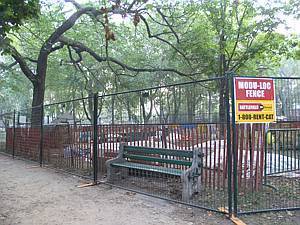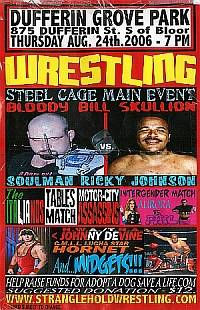Comments?
For the basics, see
- Website & Privacy Policies
- How To Get Involved
- The Role of the Park
Search options:
Department Site Map
Custodians:
 September 2006
September 2006
posted September 6, 2006
Quick Page Table of Contents
Scanning...
Friends of Dufferin Grove Park Newsletter
Volume 7 Number 9, September 2006
Comments? editor@dufferinpark.ca
Special Events In September
posted September 12, 2006
Yoga with Dufferin Mall Youth Services
Every Thursday, 4:30 pm to 6 pm - Studio @ Bloor/Gladstone Library 4:30-6:00pm- If the weather is good we’ll go to the park
It is open and free for youth (12-24), no registration is necessary. They usually meet in the middle of the park.
posted September 12, 2006
Free prenatal yoga and campfire in the park
Friday September 22, 4-5:30pm, followed by a campfire at the park
Join the drop-in program from Seventh Generation Midwives Toronto for pre/postnatal yoga led by First Nations yoga instructor Rhianna Keon. Yoga happens from 4-5:30pm, followed by a campfire at the park. We will be making bannock over the fire. Please wear comfortable clothing.
See the Neighbourhood section.

posted September 7, 2006
Friday Night Supper Dinner Dance
Friday September 8, 6 pm to 9 pm
After supper there’s dancing with Eroca Nicols and the kids from her summer dance classes. Special guest: a teacher of traditional Arabic circle dancing.Then Park DJ Ted Carlisle will play disco, soul, funk, and old-school hip hop. On the grass beside the basketball court.
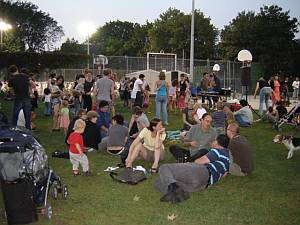
Friday Night Supper
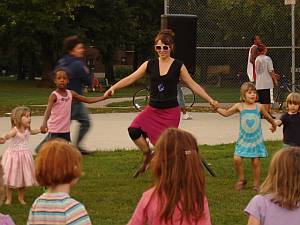
Eroca and dancers
See the Picture Gallery.

posted September 7, 2006
Annual Neighbourhood Street Fair
Saturday September 9, On Havelock Street and Dufferin Grove Park, 10am to around 9pm
- 10 am fantastic lawn sale
- clean out the basement and browse for bargains. At the park fence along Havelock Street.
- 12 noon free hot dog lunch on Havelock Street
- courtesy of Councillor Adam Giambrone.
- 2- 4 pm celebration tea
- for a special person from the neighborhood
- 4.30 pm kids’games
- games for kids with prizes, also stilt-walking, juggling, tumbling for kids with park staff Eroca and Sandy
- 6.30 pm potluck dinner and $2 pizza
- by the park bake-oven. Join your neighbours, bring plates, cutlery, extra pizza toppings.
- 7 p.m. cakewalk
- Decorate a cake in the most imaginative way you can think of, walk it around so everyone can admire it, then share it for eating.
- 7.30 p.m. after-dinner dancing with a live band
- “Gordon’s Acoustic Living Room” On the basketball court. Donations welcome to defray the cost of the band.
See the Picture Gallery.

posted September 7, 2006
Pugalug Gathering
Sunday September 10, 2 to 4 pm
The Pugalug rescue group is having a pugalug gathering at Dufferin Grove Park. There will be t-shirts, wristbands, and plush pugs for sale to raise funds for more rescues (they say they’ve rescued 29 pugs since October 2005) and for a veterinarian medical fund.
posted September 17, 2006
"Honouring our children" pow wow
Saturday September 30, 6 am, 12 noon to 5 pm
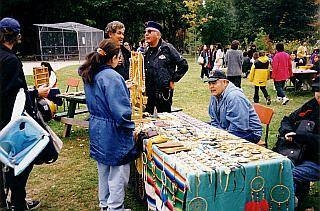
vendor at pow wow
Native Child and Family Services will be presenting their annual “Honouring our Children” Pow Wow at Dufferin Grove Park again this year. This event is a very popular, very colourful occasion with many craft vendors, dancers in beautiful costumes, free food and a big “give-away” of donated goods at the end. However, having over a thousand people in the park all afternoon can lead to some problems. Last year these problems led park staff to the idea that perhaps the pow wow would be better located at a regional park like Christie Pits, which is set up with internal roads for all the vehicles. It has no adventure playground area, and therefore no loose parts like tipi poles, rocks, wooden pieces, pails, and shovels that can become weapons if there are too many kids packed into the playground together.
However it appears that the pow wow will not be moving up to a regional park like Christie Pits this year. Instead, Tino Decastro, the Recreation supervisor of this area, will assign 5 or 6 recreation staff to be at the playground this year to supervise. Park staff Mayssan Shuja and Native Child and Family Services staff person Beverly Fanjoy are collaborating directly on how to make the playground work better for this event.

City: No kids allowed
posted September 7, 2006
Notice Of Public Meeting About Community-Built Composting Toilet
Tuesday September 12 2006, 6.30 p.m by the Cob Courtyard
This is the public meeting about the community-built composting toilet for the playground area. The meeting is on site, near the cob courtyard. The food cart will be there and the park staff will entertain the kids, so their parents can address the regulatory obstacles to building the toilet. If it rains, the meeting will be in the rink house.
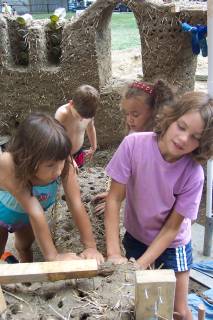
Yes! Kids allowed after all
posted September 13, 2006
Results of Public Meeting About Community-Built Composting Toilet, September 2006
Tuesday September 12 2006. Issues resolved the next day...

cob stomp with no fence
Since it rained, the meeting was held in the rink house instead. We now know that 95 adults and a whole lot of children can crowd into the rink house if necessary. The complainants who had called for the meeting didn't come, but City Parks manager Sandy Straw came, and so did her Parks supervisor Peter Leiss, and so did Recreation supervisor Tino Decastro. City Councillor Adam Giambrone was the moderator. Children as well as adults talked about wanting to help build the cob structure, wanting to have a toilet by the playground, and wanting to do something better with the environment. Georgie Donais answered questions about the way the toilet works. Many people asked the City staff and the councillor to go back to City Hall and find a way to remove the blocks to the project. They said they'd try.
They were as good as their word. Early Wednesday morning Georgie went to the Park supervisor's office for a meeting with architect Martin Liefhebber. They looked at the plans and the architect said they needed only very minor changes for him to certify them. The Buildings Department said they would fast-track the approval as soon as the certification reaches them.
Peter Leiss said that when the foundation hole is level with the ground, the project would be categorized as no longer a construction site but an art project. That means that children can help again and the fence can come down. Later, when the roof goes in, the fence will go back up briefly until that bit of construction is finished.
See also Meeting The By-Law Blues and the editorials David And Goliath and David And Goliath Two. See the Main Composting Toilet Project page.
September 13, 2006
Pictures from the meeting (pictures by Wallie Seto)
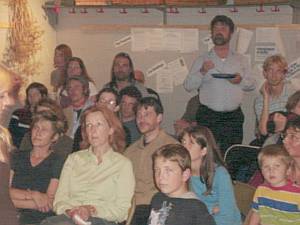 Part of the crowd |
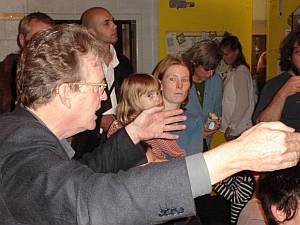 One of the speakers |
posted September 15, 2006

St.Anne's Church
St. Anne's Church flower event
Saturday and Sunday, Sept.30 and Oct.1, Gladstone and Dundas
The Garden Club of Toronto celebrates its 60th anniversary of community involvement at St. Anne's Anglican Church. [See map.]
This National Historic Site is Canada's only Byzantine Anglican church and houses the sole collection of religious art by members of the renowned Group of Seven. The front garden will be restored to complement St. Anne's unique design and a Floral Carpet will lead you into this beautiful church where floral artistry will enhance the rich interior.
There will be seed packets for children to take home.
The church will be open to the public on:
Saturday September 30th, from 9:00 a.m. to 8:00 p.m. and Sunday October 1st, from 11:30 a.m. to 6:00 p.m. Admission is free.
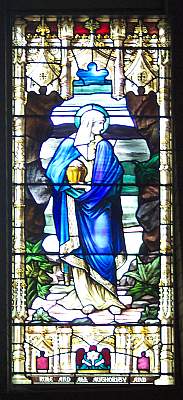
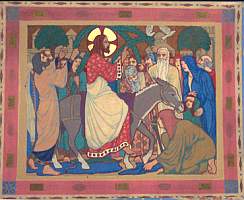
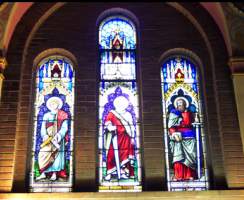
Some of the stained glass and art inside St. Anne's church.
Regular Events In September
|
posted September 7, 2006 Pizza MakingAt the Oven: Tuesdays, noon to 2 pm; Sundays, 1 to 3 pm$2 for dough, sauce, and cheese. Herbs, peppers and tomatoes can be picked from the park gardens, free. Or bring your own added toppings. On warm sundays, the wading pool sprinkler will be on, and the food cart will be at the cob near the playground. On weekends, chess sets are available, basketballs and skateboards/helmets can be borrowed from park staff. Giant checkers are set up by field house checkerboard. |
posted September 7, 2006 Dufferin Grove farmers’ marketThursdays, 3 to 7 pmThe year-round Dufferin Grove farmers’ market, by Dufferin Street near the rink house. Organic produce, meats, baking, cheese, and prepared foods. posted September 7, 2006 Friday Night SupperFridays, 6 to 7 pm (except in very bad weather)Good, cheap food from the farmers’ market, with proceeds used to help park programs. |
posted September 7, 2006
Campfire cooking
Saturdays, 1 to 3 pm, at the cob campfire near the playground
With Anna Bekerman. On warm weekend days the wading pool sprinkler will be on, and the food cart will be at the cob courtyard.
|
Anna cooking blue corn pancakes at the Saturday afternoon campfire: | |
 |
 |
posted September 7, 2006
Picnics And Campfires
Anytime
Picnics don’t need a permit and there are plenty of tables. Campfire permits are available from park staff: call the park at 416 392-0913. There are three locations: the main fire circle south of the basketball court; the smaller fire circle beside the cob courtyard, and the fireplace in the cob courtyard. Park staff give a fire-safety review, two bucket of water and another bucket for sand, and a shovel. You have to bring your own wood.
September News
posted September 1, 2006
SKATING RINK NEWS
This year most of the 51 compressor-powered outdoor ice rinks in Toronto will not open until December 9. (A few will open on December 2 -- see the list of individual rinks.) In the 1980s, rink season was standard: November 15 to the first Sunday in March, usually about 14 weeks. Those are the winter weeks with the weakest sunlight, so they work best for outdoor rinks that are artificially cooled. But in the late 1990s the rink season began to lose a few days every year. Then in 2001, City Council voted to save money by cutting all the rinks down to 10 weeks a year. (The money they saved from rinks went for more parking ticket officers.)
Since winter in Toronto is quite a bit longer than ten weeks, the decision not to open the rinks until Dec.22 that year caused an outcry from skaters, and three weeks were put back in by Parks management.
City Council never rescinded its 10-week rink decision, and so every year since then has been a cliffhanger: what length of season will parks management decide this year? Because Dufferin Rink has the largest number of vocal skaters willing to lobby, for the last few years this rink has opened a week before most others. But that brings its own problems: in 2003 there was a near-riot at the rink. So many youth come to play shinny hockey at the only open rink in their neighbourhood, that they get frustrated, struggling to find enough space to play the game.
Last year Jutta Mason took a rink petition of almost 500 names to the Economic Development and Parks Committee at City Hall, asking them to return the rink season to the original length. The City Councillors on that committee showed little interest. Most of them just chatted with each other during the 5 minutes Jutta was allowed to explain the petition, and paid no attention. It seems that unless many people can arrange to book off work for the day and crowd the committee room, petitions don’t help. And many people can’t book off.
In the end, the 2005 rink season had some extensions at the other end: although many rinks didn’t open until Dec.10, a few in every ward stayed open to the middle of March. Because the sun is so strong by then, and the ice was much too thick (insulating itself against the cooling mechanism), the rinks had to be shut down for most of those days. March is not a viable month for good outdoor ice (but November is).

outdoor shinny hockey
Recently, the Division of Parks, Forestry and Recreation was re-arranged pretty completely, and it’s still unclear how the rinks will run under the new system. We know that outdoor rinks are a wonderful winter resource for their neighbourhoods and beyond; we know that Toronto is rich in artificially-cooled outdoor skating rinks; we know that many of the rinks could be nicer places than they are now. If you’re a skater and you love these rinks, consider getting on the friends-of-the-rinks list by e-mailing sports@dufferinpark.ca (and tell your skater friends). One of these years, rink friends all over Toronto may be successful in getting the rink season back to normal.
You can also e-mail or call the City of Toronto manager in charge of outdoor ice rinks: Kevin Bowser kbows@toronto.ca phone 416 394-2486
posted September 6, 2006
REGULATION BLUES
 But the project has gotten a bit bogged down in the zealous application of rules by the City, such as this fence. Photo by Joe Adelaars. |
In the past few years there has been a new stage in the life of the park – the stage of testing whether the things that work well at the park should be banned because they might not conform to regulations or bylaws.
The zamboni crisis at the rink in 2004 was the beginning. That winter, multipurpose use of the rink house was briefly declared a health and safety infraction.
Last June, 2005, a playground user expressed great unhappiness about the possible illegality of building the cob courtyard, but by then there were too many people engaged in the project to bring it to a halt.
In July 2005 there was an anonymous complaint about people making their own pizzas at the wood oven, resulting in an order for staff to make all pizzas inside the building and rush them out to the oven. That order was quickly found to be unnecessary and rescinded.
In August 2005 there was an anonymous complaint about the farmers’ vehicles being parked at the market, but after a by-law officer told all the farmers that he would write them each $105 tickets if they returned the following week, an official permit was created. The farmers were able to continue bringing their food as before.
In November 2005 there was a large meeting at St.Mary’s High School to address the absence of a formal advisory council at the park, but the meeting participants were able to convey their confidence in a park with good staff but without a formal community meeting structure. [see results].
In February 2006 a serious standoff developed between City rinks zamboni drivers and on-site staff/rink friends, relating to our local practice of cleaning the ice one rink at a time and letting skaters continue to skate on the other rink. That issue – presented as a health-and-safety issue for the zamboni drivers – will hopefully be solved this year with the long-awaited construction of a little external paved path that allows the zamboni to travel between our two rinks without using the internal gate, therefore not requiring a guard at the gate.
In July-August 2006, complaints to the highest levels of City management, by three neighbourhood activists, led to repeated stop-work periods for the community-built addition of a composting toilet with a sculptural cob-surround, near the playground area. The worry about possible regulatory infractions made Parks management erect a six-foot-high fence to keep kids away from this project completely. A public meeting turned up no complainants willing to speak to the meeting, but a lot of ideas for how to make the project work. Parks management listened, and added input of their own, and the next day cob master-builder Georgie Donais found out that the hurdles had been crossed and the project could go ahead as planned.
This neighborhood is full of musicians: does anyone feel inspired to write a song for the park, called the “Regulation Blues”? It could have broad appeal beyond the park too, maybe become as big a hit as “Little Boxes” was in its day.
posted September 6, 2006
EDITORIAL: DAVID AND GOLIATH
(1) DAVID:
The small fellow in this fable is Georgie Donais. Last year she asked the Parks staff if they might bring in some sand, gravel, later a plumber and an electrician. She went to a local construction company and begged some clay, bought some tarps, and asked park users if they’d like to build a very old-style wall around the public health sinks that were needed for the summer food cart.
It turned out that lots of people, little and big, wanted to learn how to build using the ancient adobe method called “cob.” As the wall rose, little by little, built by so many hands of so many different sizes, the wall became a story magnet too. It seems that there’s hardly any culture that doesn’t have such buildings. People brought their photo albums from home, showing buildings in Yemen that are seven hundred years old and still inhabited, round adobe buildings in North Africa, thick-walled cob houses with thatched roofs in English villages. What a lot of joyful community talk and action! Georgie’s dad was a carpenter, and she admired his craft, but she wanted a form of building that was quiet enough for talking (not all that loud hammering). She was right. The wall went up one cob at a time, conversations led to friendships – and respect and admiration grew, day by day, for those people all over the world who developed this way of building. Georgie shaped and directed all this activity for free, and people freely came and went between the playground and the wall. Building was part of a day at the park.
At the end of September the “cob party” for people who helped was huge, and the cob courtyard has become a familiar, loved (and useful) landmark in the park.
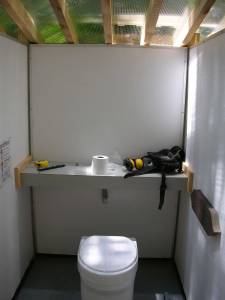
National Park composting toilet
People kept telling Georgie that one small thing was still missing: a toilet in the playground. Parents and caregivers have asked, every year, for a nearby toilet ever since the current playground went in (in the eighties). But a plumbed toilet would cost $100,000 or more and there is no such money allocated for this park.
A composting toilet, on the other hand, would be much cheaper, and it could be a little (pilot-project) step to getting a part of the park off the sewage system that pollutes our lake.
Georgie researched the newer composting toilets at national parks, which are low-maintenance, non-smelly, and very efficient. An anonymous donour – inspired by last summer’s cob wall – said he would buy one for the park ($9000). Georgie applied for funding to create a community-built shelter for the toilet, and the Toronto Arts Council gave her $10,000 (on the strength of last year’s cob wall achievement). The Toronto Parks and Trees Foundation gave her another $2000 for materials and for the living roof (like the living roof on the end of the cob wall, full of flowers and native grasses). Georgie put the word out, and by the beginning of June, work was ready to begin.
(2) GOLIATH:

kids at last year's cob project
That’s Big Bureaucracy, in this fable. The composting toilet Georgie bought was the same as the one that’s been used for at least seven years in many national parks in Ontario and across Canada. The Class one composting toilet and its tiny surround are exempt from building permit requirements. But because this community art project has some attributes in common with a conventional construction site, the situation becomes muddied. The Goliath of bureaucracy paints reality in big, bold strokes: any building site is a safety hazard, whether it’s the new ROM or a little cob housing built around a single playground toilet. At construction sites, unless there’s a big fence to keep them out, people can break their necks, or be killed plunging down four-story holes. They can lose eyes and limbs. If a provincial inspector comes and finds a parent helping a kid apply clay to shape a little wall, and one or both of them are not wearing regulation steel-toed boots, the Park supervisor could be personally fined $15,000, or $50,000, under the Health and Safety Act, and he’d have to re-mortgage his house.
And then there are the environmental hazards. Just because the toilet is a state-of-the-art model used in national parks doesn’t mean the urban Goliath accepts it. An engineer is necessary to re-certify its design (at a price of more than half the toilet). And perhaps there needs to be an environmental assessment: what if this little seasonal toilet would spread pollution? What if the kids’ little bums were to contaminate the ground so widely that the poison would leach into the wading pool? What if a composting toilet poisoned the groundwater for the neighbouring houses? Will the City’s insurance cover that? (Eeeek!)
“David and Goliath” is a fable. If the fable is true, the good sense of the community might be the pebble that knocks Goliath out of the way of this little composting toilet. We’ll see how the story unfolds, at the September 12 community meeting. The nicest outcome would be if the “Davids” of the bureaucracy (those exist too) and the “Davids” of the community could work together to support the gifts that Georgie brings to the park. Then next year it would be safe to step near the playground trees again (i.e., the current frequently-used “toilets”), and parents and caregivers could relax when their little ones say, for the third time in an hour: “Daddy, I need to pee!”
Jutta Mason
posted September 17 2006
David and Goliath: Take Two
In the first edition of this September newsletter I wrote about the fable of David and Goliath in a Dufferin Grove Park version of little versus BIG. The role of small fellow in this fable was played by Georgie Donais. To go back: last year Georgie asked the Parks staff if they might bring in some sand, gravel, later a plumber and an electrician. She went to a local construction company and begged some clay, bought some tarps, and asked park users if they’d like to build a very old-style wall around the public health sinks that were needed for the summer food cart.
It turned out that lots of people, little and big, wanted to learn how to build using the ancient adobe method called “cob.” As the wall rose, little by little, built by so many hands of so many different sizes, the wall became a story magnet too. It seems that there’s hardly any culture that doesn’t have such buildings. People brought their photo albums from home, showing buildings in Yemen that are seven hundred years old and still inhabited, round adobe buildings in North Africa, thick-walled cob houses with thatched roofs in English villages. What a lot of joyful community talk and action!
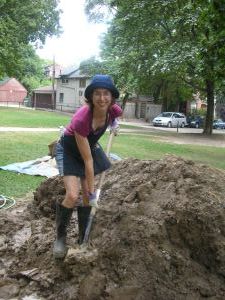
Georgie digging clay
So the cob courtyard was built. At the end of September the “cob party” for people who helped was huge. The cob courtyard has become a familiar, loved (and useful) landmark in the park.
This year Georgie sought and obtained outside funding to add the one small thing that was still missing: a toilet in the playground. Parents and caregivers have asked, every year, for a nearby toilet, since the current playground went in (in the eighties). But a plumbed toilet would cost $100,000 or more and there is no such City money allocated for this park. So Georgie planned out a composting toilet (more environment-friendly anyway), with a beautiful community-built cob surround.
The role of big fellow in our fable here was taken by the Big City Bureaucracy. There was a side player: a neighbourhood resident passionately opposed to the project, and diligent at sending letters and e-mails to the people on top. So the project was repeatedly stalled, a big fence was put up, policy orders were given that made the project impossible. City Councillor Giambrone called a meeting.
In the original fable, David knocks out Goliath with a slingshot. But at the park meeting nobody got knocked out. Even if the complainant had come, she wouldn’t have been knocked out – but she didn’t turn up, anyway. However there was a very intense discussion, in a packed rink house. Popular democracy is alive and well!
The many “Davids” at the meeting (including some eloquent children) made their arguments in favour of community good sense instead of one-size-fits-all corporate risk management. There were a lot of points made, and the representatives of the “Goliath” of City management listened very carefully.
Since when does Goliath listen? But in our fable that’s what happened. By the next morning, the Parks management had worked out the remaining blocks to the composting toilet project, with encouragement from the councillor. Georgie was able to confer directly with well-known architect Martin Liefhebber, whom parks management had hired to help the project get official certification. He told Georgie that her plans are sound. And Parks supervisor Peter Leiss told Georgie that once the foundation hole is level, the sculptural cob surround part will revert to being a community art project (funding comes from the Toronto Arts Council). That means the fence can come down and kids can help build.

kids can build with clay
Before the meeting, at the end of the first version of this newsletter editorial, I wrote: The nicest outcome would be if the “Davids” of the bureaucracy (those exist too) and the “Davids” of the community could work together to support the gifts that Georgie brings to the park. Then next year it would be safe to step behind the playground trees again (i.e., the current frequently-used “toilets”), and parents and caregivers could relax when their little ones say, for the third time in an hour: “Daddy, I need to pee!”
Well, that’s what happened. In everyday life, people don’t live happily ever after, as they might in fables. But sometimes things work out a lot better than one expects.
posted September 6, 2006
TREES FOR THE PARK
|
For a few years now, the City Forestry section has been promising new trees for Dufferin Grove Park (so that it will remain a grove for the next generation). Last fall it didn’t happen, and this spring it almost happened but they were too busy with other plantings. Forestry planner Uyen Dias has now sent word that this fall the park will for sure get its twenty-five new trees. The species are: Freeman Maples, Red Maples, Sugar Maples, White Oaks, Bur Oaks, and Red Oaks. These will be trees with pretty big root balls. The park has trees in all its community-planted native-species areas. Some of them were tiny when they went in but have now – ten or less years later – become very tall. There is a twenty-foot trembling aspen in the “Little Tree Nursery” south of the field house. It may have arrived when a bird flew over – nobody planted it. The three black walnut trees in the “Remembering Garrison Creek” garden at the southwest corner are full of walnuts this year for the first time. The swamp willow on the hill near the marsh fountain is another mystery tree – it just appeared there as a two-foot bush about five years ago. Now it’s tall and, well, willowy. The two black maples donated by Mary Wigle in memory of Ziggy Kapsa, planted near the cob courtyard, are looking strong and healthy, as are the four silver maples planted south of the wading pool just last year. |
There are also two other new maples, each with a donor inscription. Last year one of those maples almost died in the drought, and the recreation staff had to water it back to life. This year the weather was so wet that all the trees look happy. A request: if anyone knows the story of those two donated Freeman maples – who gave those to the park, and what’s their story? – please let the park staff know. People ask about those trees but the park staff don’t know what to tell them. 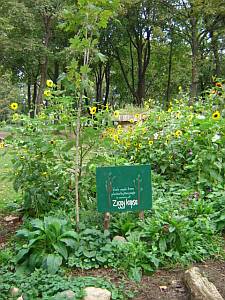 Ziggy Kapsa memorial trees |
posted September 6, 2006

Supt. Ruth White
A VISIT FROM FOURTEEN DIVISION SUPERINTENDENT RUTH WHITE
TORONTO POLICE
One morning in summer, park staff person Amy Withers came across a police car parked by the basketball court. The officer said he was watching for drug deals, but since there seemed to be nobody around, Amy brought him a copy of the park newsletter, so that he could become a little more acquainted with what goes on in this park. The officer refused it, and drove away. In case Amy’s offer alarmed the officer, Jutta wrote to the superintendent, asking if she might visit the park, meet the staff and whatever park users are around, and talk about what goes on here. Time for a fresh start!
Supt. White’s very friendly assistant Barbara called as soon as the letter arrived, and settled on a date: Thursday September 21, at 1 pm
posted September 6, 2006
ONE-TIME-ONLY WRESTLING SHOW
At the end of August there was a real pro-wrestling show in the park, on the rink pad. When the organizer first approached park staff with his dog-shelter-fundraising proposal three weeks earlier, the staff asked around among park users and found surprising enthusiasm for the idea. The park skateboarders were particularly excited, since they like a challenging spectacle.
Opening the park to many different people’s events is one of the ways the park has become so lively. And not everyone likes theatre and dance. So the park staff agreed to make this a jointly-run event (the lead time would have been too short for a City permit). They made conditions – no tickets, only pay-what-you-can donations, family orientation, event over by 11 p.m., no loud amplified music. All was agreed to.
On the day of the wrestling, this arrangement fell apart a little. Park staff Eroca Nicols had to stand beside the money person all evening to make sure that payment was voluntary. Negotiations about the amplified music settled on only amplified announcements, no music – but those announcements could be heard inside every house in the neighborhood. The show started an hour late.
Still, there were lots of neighborhood people who came, and lots of new people too, who don’t usually use the park. The rink house changeroom, so often full of dancers or parade marshals or theatre people outside of rink season, was full of wrestlers waiting for their slot. There were moments of good fun.
At the end it wasn’t so good. The last fight involved throwing chairs and smashing fluorescent glass tubes over wrestlers’ heads. One of the two final wrestlers, not a young man, had been seen drinking earlier. At the end of the match, he was lying on the floor of the ring, knocked out, and the blood was more than ketchup. When it was over, the spectators left, the rink lights went off, the ring was disassembled and trucked away. The “loser” refused to go to the hospital, after he came back into consciousness, but hobbled to a truck, groaning, leaning on his escort. The “winner” of the final match, who was also the organizer of the whole show, had to clean up almost solo. At the end he was bundling the sound system into his rented van in the dark, groaning from where the flying chairs had hit him, while the park staff swept up the broken bits of fluorescent tubes. Show business sure looked unappealing that night! And now we really know that pro-wrestling doesn’t fit into the park.
posted September 6, 2006
FARMERS’ MARKET SURVEY

Market manager Anne Freeman has sent a report about Mary Lou's market survey project. Almost a hundred people filled out Mat Lou’s very detailed questionnaire. Anne writes: Many things didn't come as a surprise, but there were useful reminders and things to be learned.
- 1) Local customers
- Although this has been a summer when we’ve observed many, many new faces, the survey emphasized how much strength comes from the immediate neighbourhood. Over 70% of respondents come from under 2km away. Just over 40% walk, a quarter drive and a quarter bike, the rest take the TTC.
- 2) Steady customers
- 57% of the respondents shop at the market every week, and another 16% come every other week; we have a very dedicated group of regulars. About 40% said that they shop at other markets as well; this included Kensington and St. Lawrence as most common.
- 3) Ages
- 28% of respondents were in their twenties, 32% in their thirties, 20% in their forties, 9% in their fifties.
- 4) Household size
- 16% shop for one, 31% shop for two people, 26% for three, the remaining 14% for four or more.
- 5) How they found it
- Almost half learned about the market from a friend or word of mouth. It's the best advertising there is! Another 24% said they found us because of our location in the park.
- 6) Other park use
- Almost half of respondents attend other events in the park, notably theatre.
- 7) Time at the market
- A third of shoppers spend about an hour at the market, almost a third spend thirty minutes or less, and the others stay 2, 3 hours or even longer.
- 8) Favourite things
- When asked what the most important aspects of the market are, "local" and "organic" were tied for by far the most significant. Meeting producers was next in importance, then the community meeting place that the market offers, with price just below on the list, and specialty foods lower in priority. We also asked customers to tell us their favourite things about the market, and here again, local and organic were mentioned many times, along with the friendly, community-oriented atmosphere, the quality and the variety.
- 9) Eating habits
- Many people felt the market has had an effect on their eating habits or attitudes towards food; comments here were very positive, and the educational role of the market is clearly significant.
- 10) What’s missing
- Respondents' "wish list" and other comments:
-both earlier and later hours were requested -more winter space/complaints about winter crowding mentioned a number of times (don't we know it!) -more vendors/bigger space -a Saturday market -complaints about strollers, crowds
-an alternative to Earthbound produce -activities/events for kids & adults
-ingredients lists on products
Market web page and e-mail newsletter:
We have over 7,000 visits to the website market page per month, and over 400 weekly subscribers to the market news, so there is clearly great interest in regular info. about what's happening and what's available. If you are not on the subscribers' list and would like to be, send me an email: market@dufferinpark.ca. The market news is always posted on the website as well.
DUFFERIN GROVE FARMERS’ MARKET, EVERY THURSDAY 3 TO 7 PM
posted September 6, 2006
TASTING FAIR
Sunday, October 1st, 2006 from 1 to 4 p.m.
|
From market manager Anne Freeman: The Dufferin Grove market’s annual Tasting Fair returns on Sunday, October 1st, 2006 from 1 to 4 p.m. Join us for a wonderful afternoon of sampling seasonal delights made by chefs, market farmers and vendors, and local enthusiastic cooks. 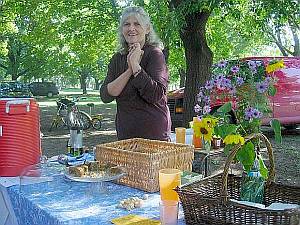 2005 Tasting fair |
Try as many tastes as you like at $2 each. There's room for more cooks on our list, so if you would like to help support the market and show off your culinary talents, we'd love to hear from you! Send me an email at market@dufferinpark.ca and we'll provide all the details. See photo gallery. 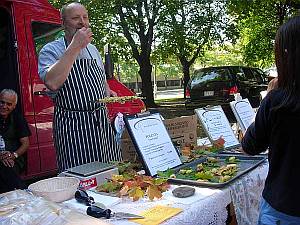 2005 Tasting fair |
Credits
|
Newsletter prepared by: Jutta Mason Illustrations: Jane LowBeer Web Site: Henrik Bechmann Dog walker liaison: Judy Simutis Park photographer: Wallie Seto |
Park phone: 416 392-0913 Web address: www.dufferinpark.ca E-mail: dufferinpark@dufferinpark.ca |



 Printer friendly version
Printer friendly version
